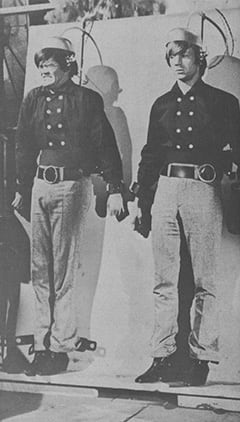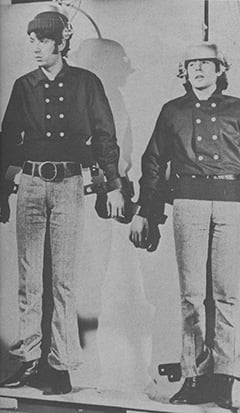“Print that,” says the director. “It’s great. We can use every second of it.”
Davy Jones looks pleased. He loves ad-libs—so do the other Monkees—and if the production team around the group weren’t like-minded, many valuable hours of filming would have been lost these last few months.
The order to print the film just shot is proof of the spontaneity of the Monkees’ ‘Scene.’
For, in the sequence, Davy:
departed from the script,
moved in the wrong direction
smiled when he should have been serious and
cracked a couple of quick blue jokes, unintelligible in America but all too clear in England.
However, the director says, “Print that,” so the sequence will be printed in “living color” and, in all probability, used in one of the episodes of TV’s “MONKEES.”
This foursome is remarkably adroit in the studio. They respond to each other with an instinct that’s surprising when you remember that they didn’t become Monkees because they were friends, but because they were hired by Screen Gems, the production company who advertised under the heading “Madness! Auditions! Folk & Rock, Musicians-Singers.”
Out of the hundreds who answered the advertisement, four were chosen and they are here in this studio today: Davy Jones, Mike Nesmith, Micky Dolenz, Peter Tork—The Monkees.
Sensations of 1967. Carefully, skillfully, deliberately prepackaged to make a fortune for their sponsors, producers, record company and associated merchandisers.
The group itself will also build substantial bank accounts this year from royalties on record sales, and no one should begrudge them this new wealth for all of the Monkees have worked hard, waited a long time and been very patient on the road to success. All have been near to starvation at some time or other.
Here in Studio Nine, at Screen Gems, by Sunset Boulevard in Hollywood the cameras are rolling for an episode to be screened in England some time in the summer.
Sammy Davis came in an hour ago. He was filming in a studio nearby and he asked to meet the new raves of the world’s youth.
Bert Schneider, producer/founder of the Monkees—he is the son of the President of Columbia Pictures—introduced Davis to the four boys and he nodded to the cameramen: “Keep ’em rolling.”
Clowning, shadow-boxing, face-pulling, dancing, handshaking, the brilliant Davis, long-time song-and-dance man, leaped around the set with the four wild boys.
Every moment of the action was filmed and that footage too will be printed—and saved. You never know when it will come in handy—for Sammy Davis or for the Monkees.
Davis has gone back to work on his own set now, and on the Monkees’ set Davy Jones is still “misbehaving,” inoffensively. He is much given to imitating W.C. Fields, greatest of the old vaudevillian movie actors of the 1930’s. He is a good mimic and his Manchester accent greatly intrigues the Americans. It gives him a mystique which is always a help in this jaded movie capital.
This is a happy studio—there is none of the alternating languid boredom, ill temper, or displays you find on other movie/TV lots.
It is one of the few sets where normally-inviolate rules are broken. Several of us are talking and laughing while the action progresses. This is part of the Scene. There are many visitors—several girls. Teenagers—with special permission—are allowed on the set. Visiting stars—and there are many of them—are encouraged to bring their children with them. The Monkees are very pleasant with guests. Not studiedly so—just natural and relaxed.
Not so long ago a trip to the “Uncle” set or the “Batman” studio was the major TV prize-visit for young people over here. Now the Monkees have taken over. They are the hottest thing in America.
At this moment, in this cheerful, brilliantly-lit studio you’d never know they were stars.
“Woolhat” Nesmith is lounging in a chair signing autographs, not bothering anyone. He is a dour young man, very honest and direct with the cool appraising stare of John Lennon. Nearby, wearing a football helmet, stands Peter Tork. He is talking to a sun-bronzed blonde of about seventeen. She is staring into his eyes as if he were the Prince of Peace. His own attitude is simple and relaxed, and he has a wide grin very unlike the Prince of Peace.
Micky Dolenz—former TV “Circus Boy”—is sipping coffee from a paper cup, and Davy is serious this moment, talking to director Robert Rafelson who listens intently.
Both Rafelson and Schneider are good listeners. They respect the views of the Monkees and the Monkees respect their producers. It is a good Scene.
Often, on set, the Monkees are told just, “go crazy, do whatever you want.” And the director has the sequences shot with a hand-held camera—in the manner of “Hard Day’s Night,” on the success of which the Monkees TV series is unashamedly based.
Today they have impersonated bullfighters, drunks and giraffes, fought Indians, escaped from wild gypsies. Other actions—not suitable for public viewing—have occurred off-camera. It is all great fun.
It is also hard work and the Monkees are having a full day.
It started at 8:00 a.m. and it will go on until dusk. All of today they will spend indoors, but tomorrow there are plans for The Ranch, the fixed outdoor Screen Gems location on which technicians can build a desert, a jungle, a London street or a Mexican fiesta—whatever is wanted.
Schneider and Rafelson make sure that the Monkees are not troubled in their off-duty hours. They have learned many lessons already, and unlike any previous pop group—for Monkees are unlike any previous pop group—these four boys will not be subjected to excessive touring, fan-club, press or photographic demands.
They are human beings, said Schneider, and they will so remain.
The evidence in the studio today suggests that they will.



